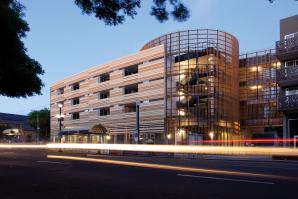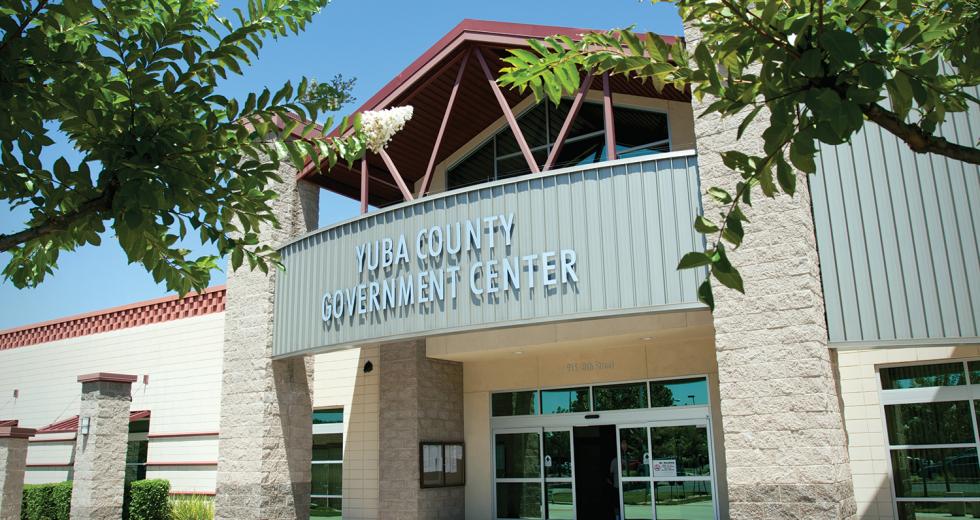Yuba County’s infrastructure was crumbling and its budget bleeding red ink when officials came up with a catching solution to their energy problems.
They used grant, rebate and tobacco money to help fund a $10.8 million energy enhancement project and chose solar panels projected to save enough in energy costs to pay the debt service on a 16-year, 4.5 percent loan. All this, and they didn’t have to tap an already depleted general fund.
The bet is going green will pay off in the long run with more energy cost savings and a smaller carbon footprint, a win-win for any entity trying to balance its budget and meet the requirements of Assembly Bill 32, the Global Warming Solutions Act.
“The stars aligned all the way around,” Yuba County Administrator Robert Bendorf says.
Yuba officials could have waited, hoping the nearly 50-year-old heating and air-conditioning system in their courthouse could hold on for a better economy. But the thought of having to close the building and pay for a temporary fix if something went wrong didn’t sit well.
Neither did dipping into the general fund, no small matter in a county with a $10.7 million structural deficit in this past fiscal year. Yuba officials instead relied on a $323,000 Energy Efficiency and Conservation Block Grant Program, $800,000 in tobacco securitization funds and rebates from the California Solar Initiative and Pacific Gas & Electric Co. totaling more than $1.5 million.
The 1.15-megawatt project, done in partnership with Chevron Energy Solutions, should generate substantial savings once the 16-year loan is paid. With the solar panels expected to last about 30 years, Yuba officials anticipate annual savings near $1 million for the remaining 14 years.
“It allows us to not only take a step forward and make sure we’re energy efficient, but it also allows us to address our aging infrastructure,” says John Fleming, economic development coordinator for Yuba County.
Waiting for better budgetary times to move forward could have proven disastrous.
“Let’s just wait till it [breaks down],” says Doug McCoy, the county’s director of administrative services. “That’s kind of the wing-and-a-prayer philosophy. I just didn’t think that was the right solution. If the economy doesn’t turn around and it does give out, we’d really be in a pickle.”
Fleming agreed.
“It would have cost us thousands and thousands of dollars,” he says. “If there had been a significant failure of that system with court in session, we’d have to roll something in on a quick basis to provide heating and cooling.”
Yuba officials spent two years looking at several companies before choosing Chevron, which has done a variety of similar projects for local governments, schools and businesses.
“We really did want to come up with a way that would fix the infrastructure problem in a way that didn’t affect our general fund,” McCoy says. “Chevron Energy Systems had the best energy solution, the best package, we felt, in terms of meeting our needs.”
Chevron’s deal includes the assurance that if energy savings don’t reach 95 percent of projections, Yuba County will receive a check for the difference. “The benefits for the county are they can fix their infrastructure, and the money comes from energy savings,” says Ashu Jain, a Chevron senior business development manager.
The Yuba project, expected to begin this summer and be completed in a year, includes energy enhancements such as installing water conservation systems in the county jail and juvenile hall and solar panels on the government center and health services building, among others.
“Considering the magnitude of replacing these systems, it was important for us to look at things and be as cost-conscious as possible,” Bendorf says.
Also a factor was state AB 32, which requires annual mandatory reporting of greenhouse gas emissions and established emission limits. AB 2466, which allows local governments to generate credits and use them to offset costs at other locations within their geographic boundaries, has also impacted local counties’ decisions.
“As we move forward, we anticipate there’ll be more mandates and more activities,” McCoy says. “To some degree, it forces us to become more efficient.”
As Yuba County moves in a greener direction, nearby counties find themselves at varying stages in the quest for energy efficiency.
Sutter County doesn’t have any solar projects in the works, but it’s using $141,606 from the Energy Efficiency and Conservation Block Grant Program to upgrade light fixtures in county buildings and replace street lights at the intersections of county roads and state highways, according to senior civil engineer Neal Hay.
“I believe the forward thinking of taking a look at energy efficiencies and the program will put the county in a much better position when it comes to saving money.”
John Fleming, economic development coordinator, Yuba County
Butte County is already well down a similar solar path, having partnered with a company that’s now SPG Solar Inc. in 2004 to install an $8.4 million, 1.18-megawatt solar facility that included 6,360 solar panels.
The concept was similar to Yuba County’s deal: Save energy with solar, then use the savings to pay for debt service on the energy loan. Butte County didn’t have to reach into its general fund for upfront costs either, relying on a $4.2 million PG&E rebate, a $3.2 million loan from the California Energy Commission and a $1 million loan from the Butte County Investment Pool.
Grant Hunsicker, Butte County’s director of general services, says the original estimated loan payback of 13.2 years now looks closer to 15 years. Once the loans are paid, the county hopes for estimated savings of $316,000 annually.
“PG&E rates did not increase as sharply as the original model had predicted,” Hunsicker says. “Some years, we don’t quite cover the amount of debt service. Other years, we do.”
Maintenance is another issue with the solar panels. Butte officials expect the panels to last 20 to 25 years instead of the 30 years in Yuba.
“It’s one of those things where technology is constantly improving,” says Paul Hahn, Butte County’s chief administrative officer. “It’s like buying a computer; 18 months later, there’s a better computer out.”
Butte officials say they’ll consider additional solar projects but first want to develop a blueprint for adding facilities.
“We need a comprehensive design, so we don’t plop down solar panels where we need additional facilities,” Hunsicker says. “There’s a lot of pieces to that, looking at potential central plants.”
Hahn says the solar program’s success would likely lead to similar projects.
“They’re still on target to pay for themselves and provide an alternative form of energy as we go forward,” he says. “Certainly additional solar would be something we’d absolutely consider.”
While Hahn notes the influence of AB 32 in heading in a greener direction, he says the cost was a greater factor. “Dollars and cents is what’s driving things these days,” he says.
Yolo County has done three solar projects since 2006, according to Terry Vernon, Yolo’s deputy director of general services. The most recent was a 1-megawatt solar power system at the Yolo County Justice Campus in Woodland.
That project was paid for by bonds and a 15-year loan from the California Energy Commission.
“It’s making money from day one,” Vernon says.
Yolo County officials say they’ve reduced greenhouse gas emissions by 38 percent from 2006 to 2009. The Justice Campus solar project is expected to push the reductions to 50 percent this year.
“It all definitely reduces our energy costs,” Vernon says. “Think about your own house. ‘I’m just going to eliminate my electric bill.’”
But the formula isn’t the same everywhere. Sacramento County has installed solar panels on some of its buildings, but energy manager Dan Mendonsa notes the Sacramento Municipal Utility District’s rate structure doesn’t provide for as much in potential energy cost savings as PG&E’s does in surrounding counties.
“We can make solar panels pencil (out) here, but it’s just very expensive,” he says.
For those who can make the numbers work, the future looks good. And green.
“I believe the forward thinking of taking a look at energy efficiencies and the program will put the county in a much better position when it comes to saving money,” Fleming says. “We’re doing it appropriately, making sure 10, 15, 20 years down the road … we’re operating much more efficiently.”
Recommended For You

Green for Green
Alternative financing for sustainable development
Developers looking to build in the Capital Region are finding cash in emerging green-financing products.

Levee Over Troubled Waters
Paying for repairs just got harder
It’s a calm, clear day on West Sacramento’s South River Road, a meandering two-lane route that runs atop a levee buffering houses and farmland from the placid Sacramento River. It’s hard to envision the chaos that would ensue if the great dirt barrier were to burst, pouring millions of gallons of water into adjacent homes and businesses, but that nightmare scenario just got harder to prevent.



